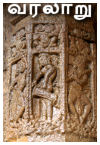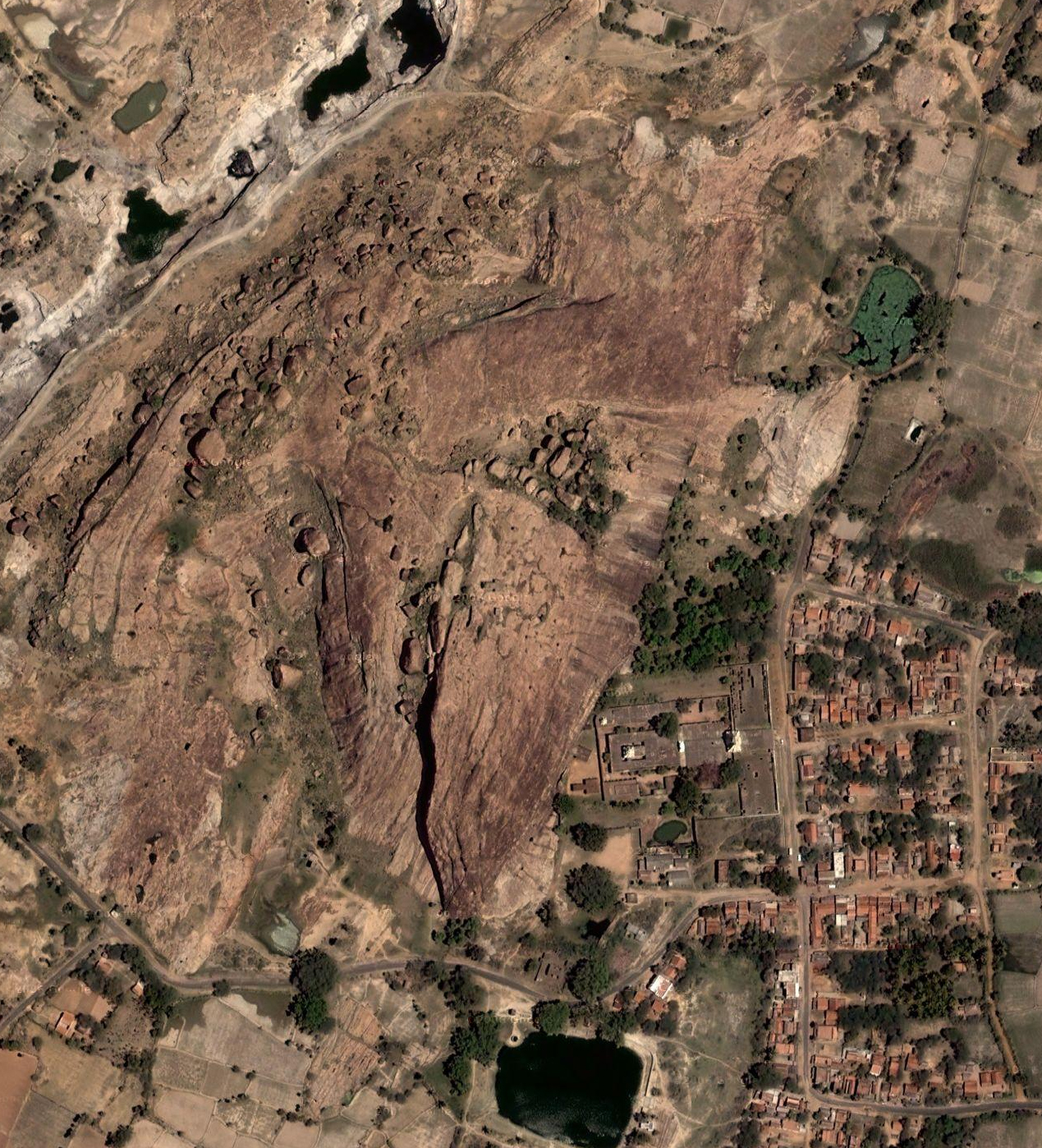 |
 |
 |
http://www.varalaaru.com A Monthly Web Magazine for South Asian History [184 Issues] [1822 Articles] |
 |
 |
 |
http://www.varalaaru.com A Monthly Web Magazine for South Asian History [184 Issues] [1822 Articles] |
|
Issue No. 59

இதழ் 59 [ மே 15 - ஜுன் 15, 2009 ] 
இந்த இதழில்.. In this Issue.. 
|
Series:
Pudukkottai Cave Temples
Kudumiyanmalai is one of the important places in Pudukkottai district is noted for its millennium old monuments and the celebrated Musical Inscription. Colloquially the place is known as Kudumiyamalai. It is nearly 45kms from Thiruchirappalli and one can reach Kudumiyanmalai from Thiruchirappalli by traveling through Viralimalai-Iluppur-Annavasal route. And it is about 15kms from Pudukkottai lies on Pudukkottai-Kodumbalur-Manapparai route.
 Bird Eye View Of Kudumiyanmalai Hillock with The Temple Complex On The East (COURTESY : GOOGLE MAP) Kudumiyanmalai is a great historic centre which is confirmed through the presence of the huge temple complex with copious inscriptions. Budding as a small rock cut temple in the early phase it developed as a huge temple complex in the later period shows it as centre gaining momentum in passage of time. The huge hillock present in the middle of the village is the great centre of all socio-cultural activities starting from the historic period. We can trace its historical importance even from the early Christian era, which is attested by the presence of Jain vestiges on the western side of the hillock. The village is extended all around the hillock, where the dwellings are seen only on the eastern side. On the eastern precipice of the hillock on its foot is seen the rock cut temple called Melaikkovil, which the inscriptions call as Thirumerrali. Near the Melaikkovil to its left is seen the famous Musical Inscription and a giant ganesa bas-relief sculpture. Apart from the rock cut temple, the Main Shrine, Soundaranayaki amman shrine, Vinayaga shrine and Akilandeshwari shrine are the structural temples which originated in the subsequent eras forming it as a huge multifaceted temple complex. There is also a Murugan shrine in the summit of the hillock. Kudumiyanmalai is a treasure-trove of inscriptions. There are nearly 120 inscriptions in the temple complex out of which 40 are found in the rock cut temple alone. Endowments in the form of kind or cash for various offerings to the deities are the main concept of the inscriptions. But these treatises in disguise divulge the history of the temple and the region. It picturize Kudumiyanmalai as a great centre of political, social and economic activities which enjoyed the perpetual patronage of all the great and lesser dynasties of the Tamil country till the advent of the English. It also gives us ample information about the enormous wealth possessed by the temple in and around Kudumiyanmalai. We come to know about the renovations, additions made by various kings and chieftains in succeeding eras to this temple. The early inscriptions mention the village as Thirunalakkunram whereas in the later period it was called as Sikanallur on behalf of the presiding deity Sikanatha. Another distinguishing feature of Kudumiyanmalai is the musical inscription engraved on the rock face to the south of the rock cut temple. The language of the inscription is Sanskrit and the script is Pallava Grantha. It is a rare treatise on musical notes. At the end of the musical notes is seen a colophon which reads as “composed by the king, who is a great devotee of Mahesvara or Siva and who is a disciple of Rudracarya, for the benefit of the sisyas”. A mysterious question arise “Who could be this Royal Disciple?” Another inscription inside the rock cut temple names the musical instrument “Parivadini”. Scholars suggest that the notes denoted in above mentioned inscription might be applicable to this instrument. All these imply that Kudumiyanmalai might be a great cultural center or a learning centre of music. Among the inscriptions in the temple complex the earliest one belongs to Maran Sadayan found in the Melaikkovil and speaks about the endowment of a perpetual lamp to Thirunalakkunrattu Mahadevar i.e. the deity of the Main shrine. This inscription asserts the existence of both the rock cut temple and the Main shrine of Thirunalakkunram by the end of the 8th century AD. Most of the inscriptions inscribed on the Melaikkovil belong to either Early Chola or the I Empire of Pandya speaking about the endowment for the deity of the Main Shrine. This kindles the idea why the inscriptions of Main Shrine are inscribed on the rock cut temple? Why didn’t it be inscribed in the Main shrine itself? We find the solution of it in the forthcoming editions. I have come across many inscriptions speaking about the burning of perpetual lamp to the deity of Thirumerrali but the sad thing to note is not even a single lamp is lit for the deity now-a-days. Even the natural illumination is absent due to the presence of the front mandapas. This magnificent monument somberly remains in the gloominess losing all its splendor and glory. Even the village which might be once a township now remains as a small hamlet in the suburbs of Pudukkottai District. Dear readers with this small historical background I conclude my introductory part and in the forthcoming sessions we go on a virtual tour to this historical place. this is txt file� |

சிறப்பிதழ்கள் Special Issues 

புகைப்படத் தொகுப்பு Photo Gallery 
|
| (C) 2004, varalaaru.com. All articles are copyrighted to respective authors. Unauthorized reproduction of any article, image or audio/video contents published here, without the prior approval of the authors or varalaaru.com are strictly prohibited. | ||